Design and Experiment of Flexible Threshing Device with Variable Stiffness for Corn
Abstract
:1. Introduction
2. Materials and Methods
2.1. Grain Damage Regulation
2.2. Machine Structure and Working Principle
2.2.1. Overall Structure
2.2.2. Working Principle
2.3. The Design of Key Components
2.3.1. Rotor Design
2.3.2. Spring Design
2.3.3. Threshing Element Design
2.3.4. Threshing Element Analysis
3. Field Experiments and Analysis of Results
3.1. Test Conditions
3.2. Test Methods
3.3. Orthogonal Test
3.4. Analysis of Variance
3.5. Response Surface Analysis
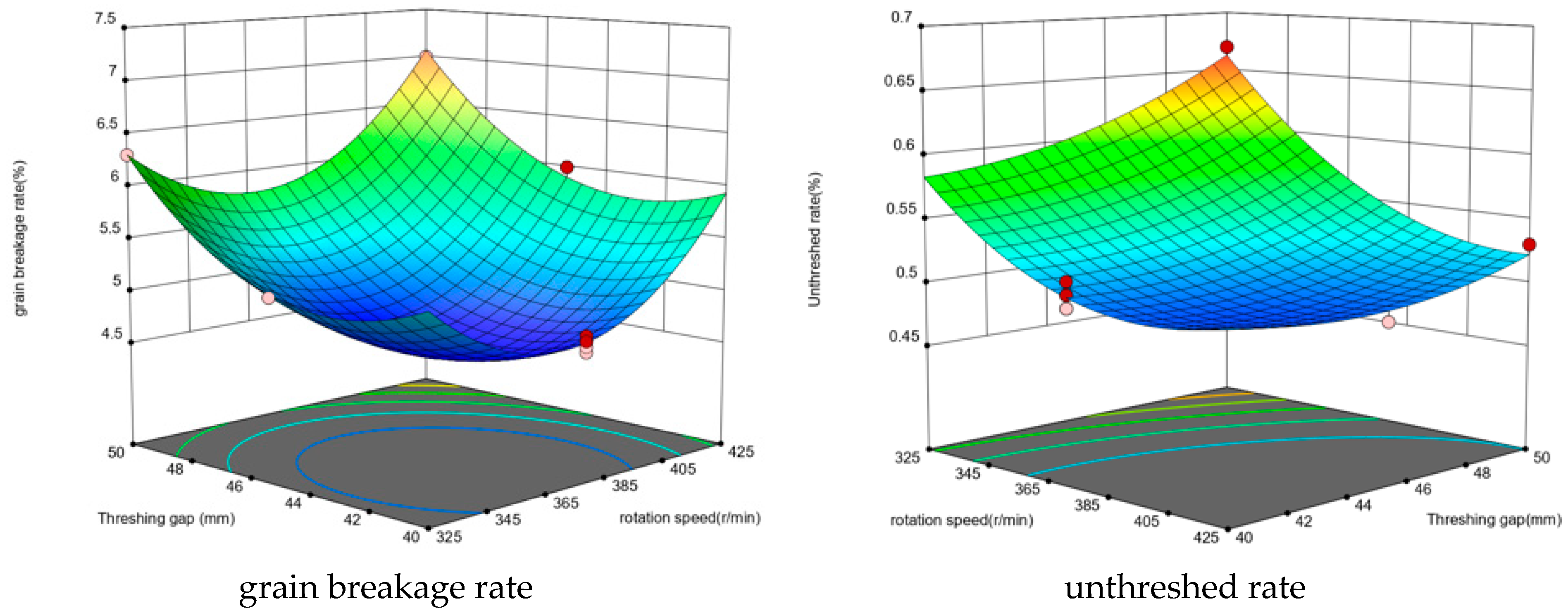

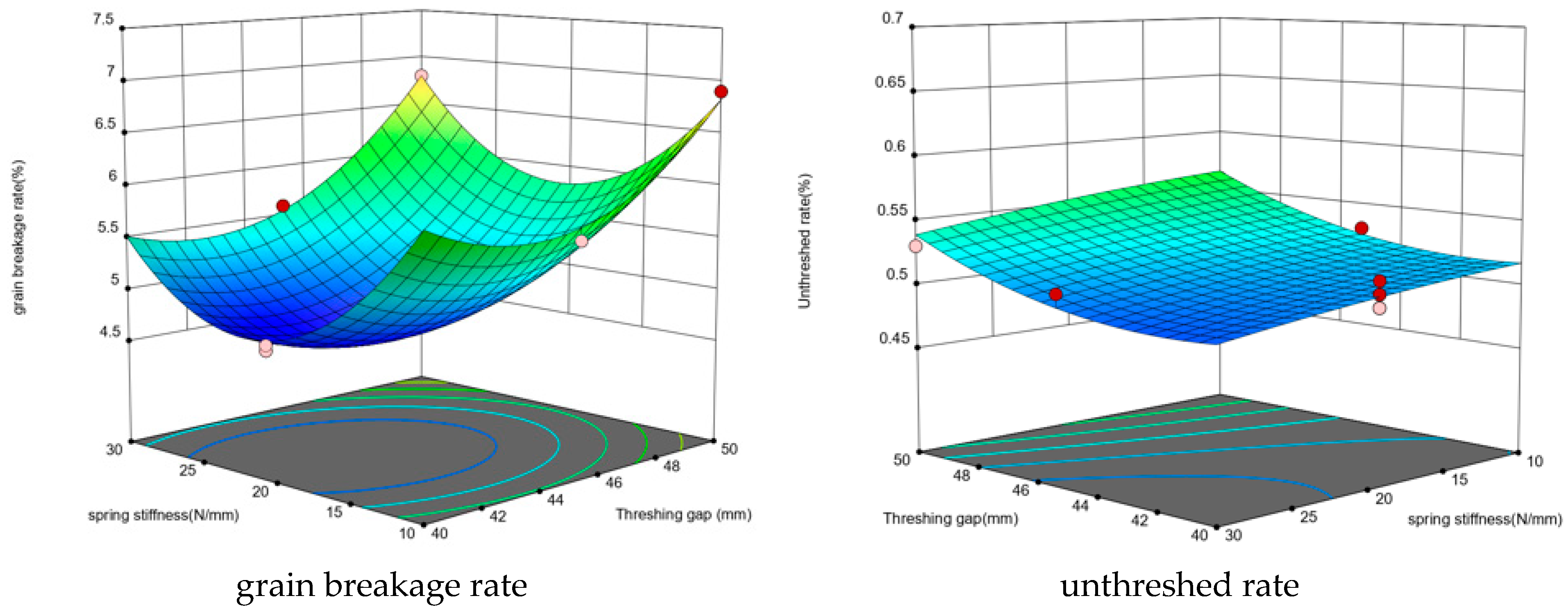
3.6. Regression Verification
4. Discussion
5. Conclusions
- (1)
- Based on the damage resistance strength of the surface of the corn grain, the damage regulation of corn was summarized, the loading characteristics of corn were studied, the optimal loading direction of corn was determined as the side, and the range of loading positions was determined.
- (2)
- In order to solve the problem of a high damage rate in the direct harvesting of corn grains in the Huanghuaihai area, a flexible threshing device with a threshing rasp bar and variable stiffness spring as the buffer carrier was developed based on the mechanical characteristics of corn threshing, and the structure of the threshing system and threshing process were studied.
- (3)
- The conical spring was designed based on the corn load variable regulation, and the optimal parameter combination under the condition of 30~31% moisture content of the corn ear was determined by the orthogonal test. In conclusion, when the rotating speed of the rotor was 375 r/min, the threshing gap was 40 mm, the spring stiffness was , and the breakage rate was 4.7%. When the rotating speed of the rotor was 425 r/min, the threshing gap was 40 mm, the spring stiffness was , and the unthreshed rate was 0.48%. Therefore, it meets the national standards (JB/T 10749-2018) [28] of corn threshing.
Author Contributions
Funding
Institutional Review Board Statement
Data Availability Statement
Conflicts of Interest
References
- Cui, T.; Fan, C.; Zhang, D.; Yang, L.; Li, Y.; Zhao, H. Research Progress of Maize Mechanized Harvesting Technology. Trans. Chin. Soc. Agric. Mach. 2019, 50, 1–13. [Google Scholar]
- Xiong, W.; Guo, Y.; Meng, S.; Wang, Y.; Sun, Z.; Zhao, Y.; Liu, H.; Yang, G.; Chen, J.; Song, X.; et al. Effects of Varieties and Sowing Density on the Biomass Yield and Nutritional Quality of Foodstuff Maize. J. Maize Sci. 2022, 30, 102–109. [Google Scholar] [CrossRef]
- Kiniulis, V.; Steponavičius, D.; Andriušis, A.; Kemzūraitė, A.; Jovarauskas, D. Corn ear threshing performance of filler-plate-covered threshing cylinders. Mechanics 2017, 23, 714–722. [Google Scholar] [CrossRef]
- Saeng-ong, P.; Chuan-Udom, S.; Saengprachatanarak, K. Effects of guide vane inclination in axial shelling unit on corn shelling performance. Kasetsart J. (Nat. Sci.) 2015, 49, 761–771. [Google Scholar]
- Petkevičius, S.; Špokas, L.; Steponavičius, D. Substantiation of technological parameters of wet maize ear threshing. Agron. Res. 2008, 6, 271–280. [Google Scholar]
- Pužauskas, E.; Steponavičius, D.; Jotautienė, E.; Petkevičius, S.; Kemzūraitė, A. Substantiation of concave crossbar shape for corn ear threshing. Mechanics 2016, 22, 553–561. [Google Scholar] [CrossRef]
- Gao, M.; Cheng, X.; Du, X.; Feng, J. Experimental study on the compression characteristics of maize kernels. Food Sci. Technol. Econ. 2016, 41, 45–48. [Google Scholar] [CrossRef]
- Tang, F.; Meng, P.; Cheng, X. Experimental study on compression elastic-plastic deformation characteristics of corn heap. Food Sci. Technol. Econ. 2016, 41, 47–50. [Google Scholar] [CrossRef]
- Cheng, X.; Fong, J.; Yan, X.; Huang, Z. EXPERIMENTAL STUDY ON STRUCTURE DAMAGE DF CORN GRAIN AFTER COLLISION. Grain Storage 2014, 43, 19–22. [Google Scholar]
- Cheng, X.; Shi, C.; Lu, L.; Tang, F. Determination and Experimental Researchon Maize Pile’s Elastic Modulus. J. Chin. Cereals Oils 2011, 26, 87–91. [Google Scholar]
- Xie, F.; Luo, X.; Lu, X.; Sun, S.; Ren, S.; Tang, C. Threshing principle of flexible pole-teeth roller for paddy rice. Trans. Chin. Soc. Agric. Eng. 2009, 25, 110–114. [Google Scholar]
- Qian, Z.; Jin, C.; Zhang, D. Multiple frictional impact dynamics of threshing process between flexible tooth and grain kernel. Comput. Electron. Agric. 2017, 141, 276–285. [Google Scholar] [CrossRef]
- Li, Y.; Zhou, W.; Xu, L.; Sun, T.; Tang, Z. Parameter Test and Optimization of Tangential-horizontal-horizontal Threshing and Separating Device. Trans. Chin. Soc. Agric. Mach. 2015, 46, 62–67+92. [Google Scholar]
- Qu, Z.; Zhang, D.; Yang, L.; Zhang, T.; Wang, Z. Experiment on Feed Rate and Cylinder Speed of Longitudinal Axial Flow Threshing and Separating Device for Maize. Trans. Chin. Soc. Agric. Mach. 2018, 49, 58–65. [Google Scholar]
- Chen, M.; Xu, G.; Wang, C.; Diao, P.; Zhang, Y.; Niu, G. Design and Experiment of Roller-type Combined Longitudinal Axial Flow Flexible Threshing and Separating Device for Corn. Trans. Chin. Soc. Agric. Mach. 2020, 51, 123–131. [Google Scholar]
- Wang, F.; Zhao, Z.; Liu, E. Analysis of nonlinear conical helical MEMS spring based on the FEM. J. Shaanxi Univ. Technol. (Nat. Sci. Ed.) 2013, 29, 1–5. [Google Scholar]
- Wang, Y. Design and Experimental Study on Corn Threshing Device with High Moisture Content. Master’s Thesis, Shandong University of Technology, Zibo, China, 2019. [Google Scholar]
- Nigwal, D.; Pasi, D.K.; Chouksey, M. Effect of nonlinear conical springs on the vibration characteristics of seven degree-of-freedom car model using MATLAB/Simscape. Int. J. Dyn. Control 2023, 11, 491–503. [Google Scholar] [CrossRef]
- Su, Y.; Liu, H.; Xu, Y.; Cui, T.; Qu, Z.; Zhang, D. Optimization and Experiment of Spike-tooth Elements of Axial Flow Corn Threshing Device. Trans. Chin. Soc. Agric. Mach. 2018, 49, 258–265. [Google Scholar]
- Wang, Z.; Cui, T.; Zhang, D.; Yang, L.; Xian, Y. Design and Experiment of Rasp Bar Threshing Element of Corn Combine Harvester. Trans. Chin. Soc. Agric. Mach. 2021, 52, 115–123. [Google Scholar]
- He, K.; Wang, Q.; Geng, D.; Jin, C.; Zhu, J.; Zhang, M. Design and optimization of the straightening and kneading equipment of Codonopsis Pilosula. J. Chin. Agric. Machaniz. 2018, 39, 53–58. [Google Scholar] [CrossRef]
- Miu, P.I.; Kutzbach, H.-D. Modeling and simulation of grain threshing and separation in threshing units—Part I. Comput. Electron. Agric. 2008, 60, 96–104. [Google Scholar] [CrossRef]
- Li, H.; Wang, Q.; Ma, J.; Wang, Y.; Yue, D.; Geng, D. DESIGN AND EXPERIMENT OF TRANSVERSE AXIAL FLOW CORN FLEXIBLE THRESHING DEVICE. INMATEH—Agric. Eng. 2023, 69, 461–470. [Google Scholar] [CrossRef]
- Qiu, D.; Seguy, S.; Paredes, M. A novel design of cubic stiffness for a nonlinear energy sink (NES) based on conical spring. In Advances on Mechanics, Design Engineering and Manufacturing; Springer: Cham, Swizterland, 2017; pp. 565–573. [Google Scholar] [CrossRef]
- Ren, J. Study of Mechanics Analysis of Equal–pitch Conical Helical Spring Based on MATLAB. Mech. Res. Appl. 2013, 26, 10–11. [Google Scholar]
- GB/T 21961-2008; Test Methods for Maize Combine Harvester. Standardization Administration of China: Beijing, China, 2008; p. 16.
- GB/T 21962-2008; Technical Requirements for Maize Combine Harvester. Standardization Administration of China: Beijing, China, 2008; p. 12.
- B/T 10749-2007; Maize Thresher. Chinese Academy of Agricultural Mechanization Sciences: Beijing, China, 2007; 10p.
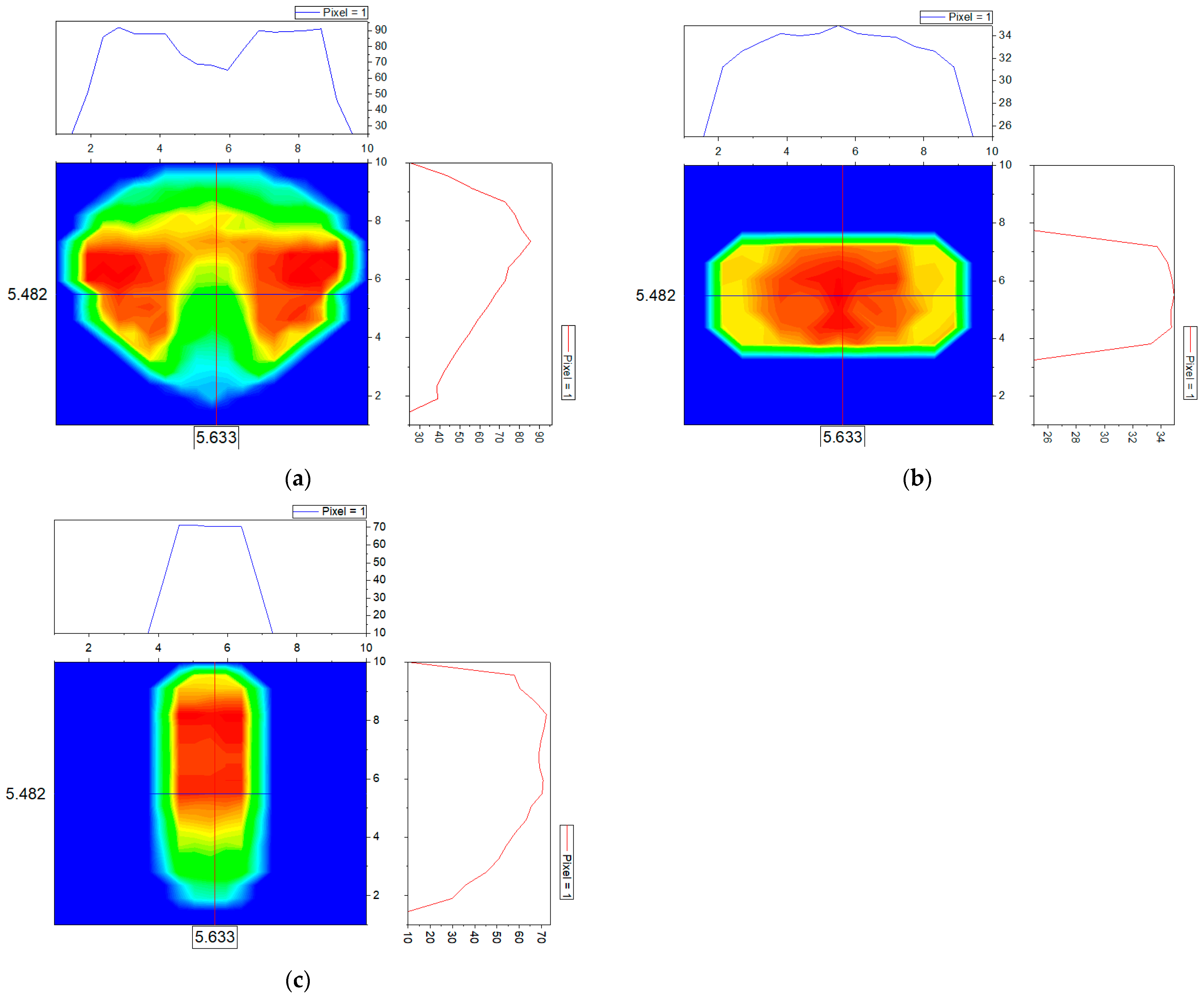




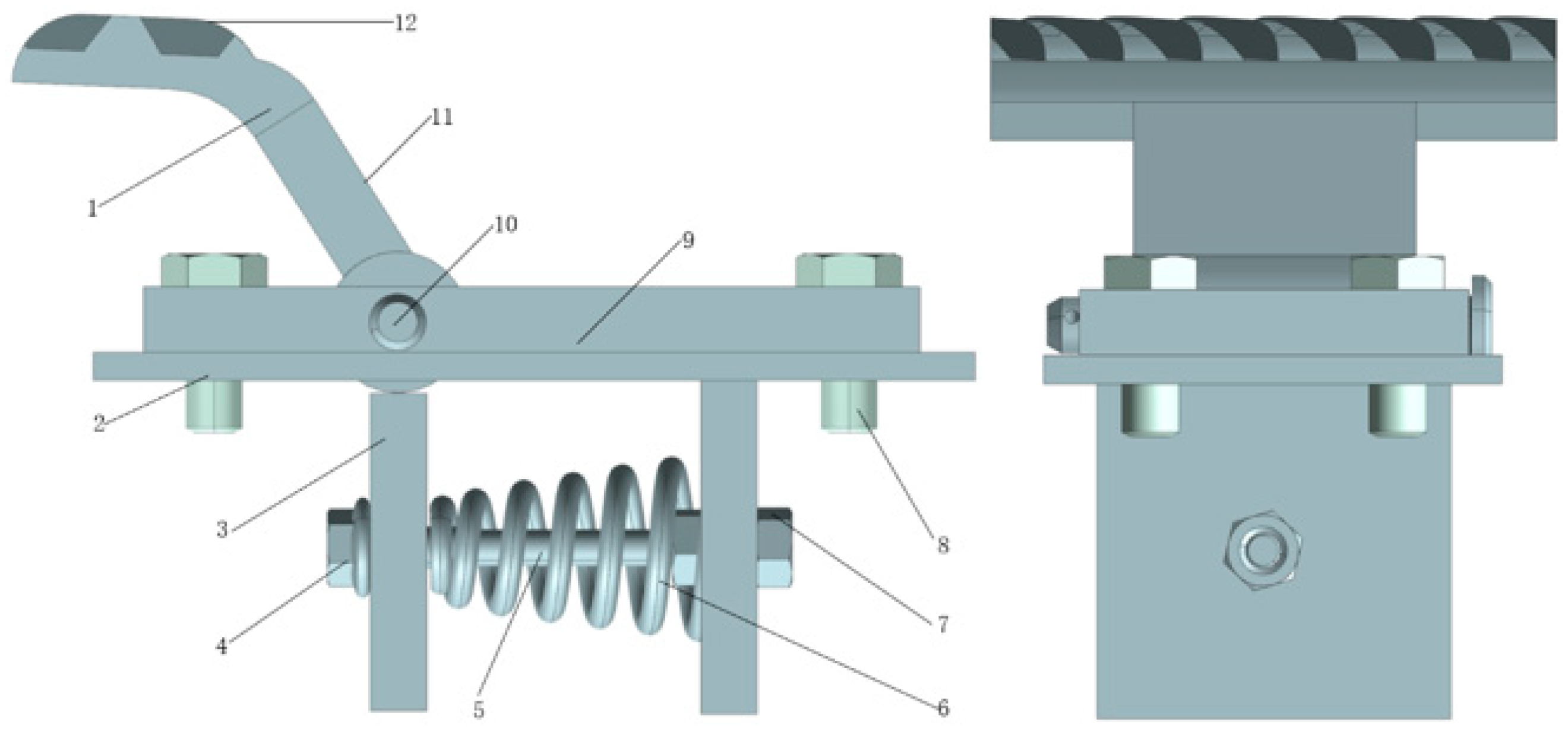
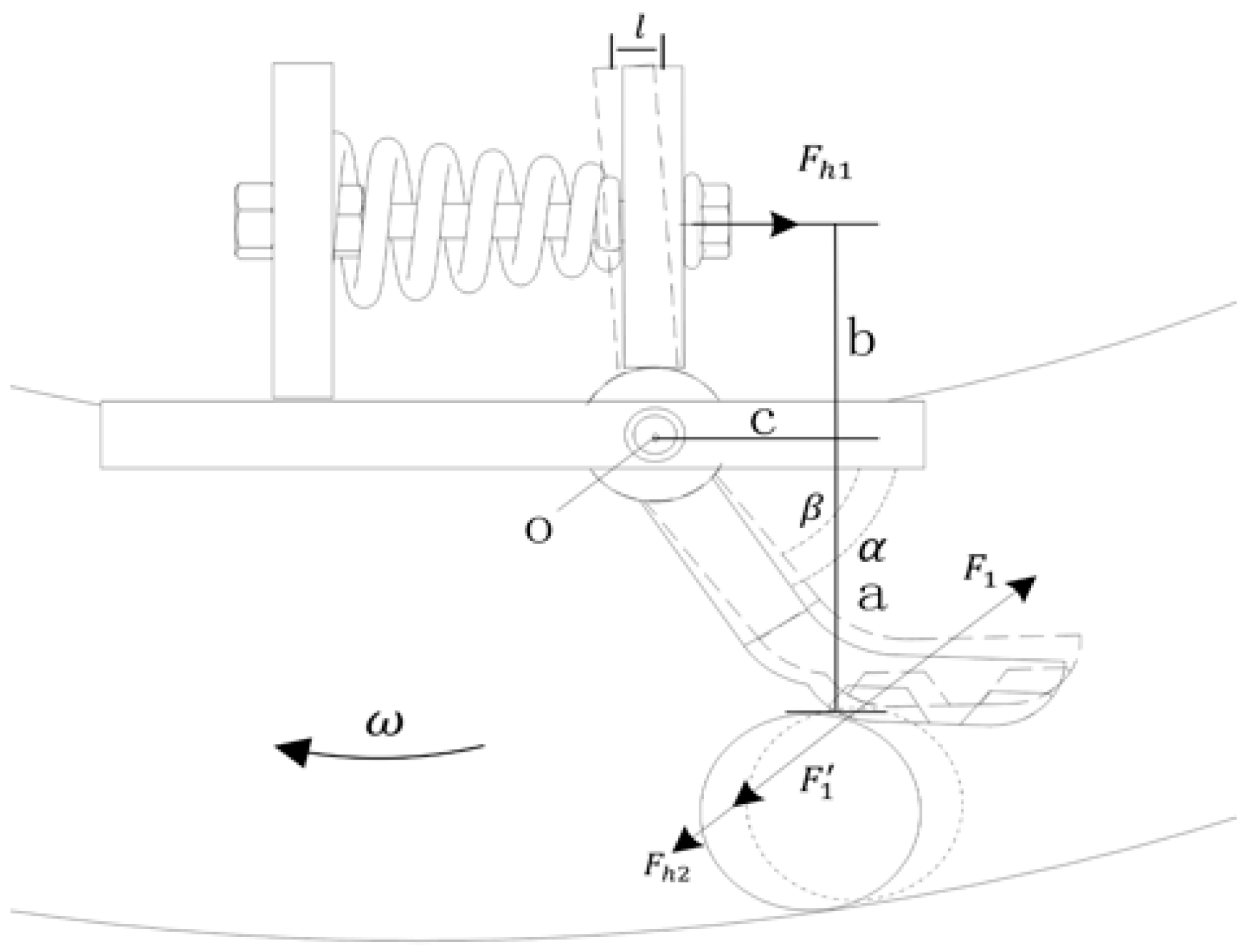
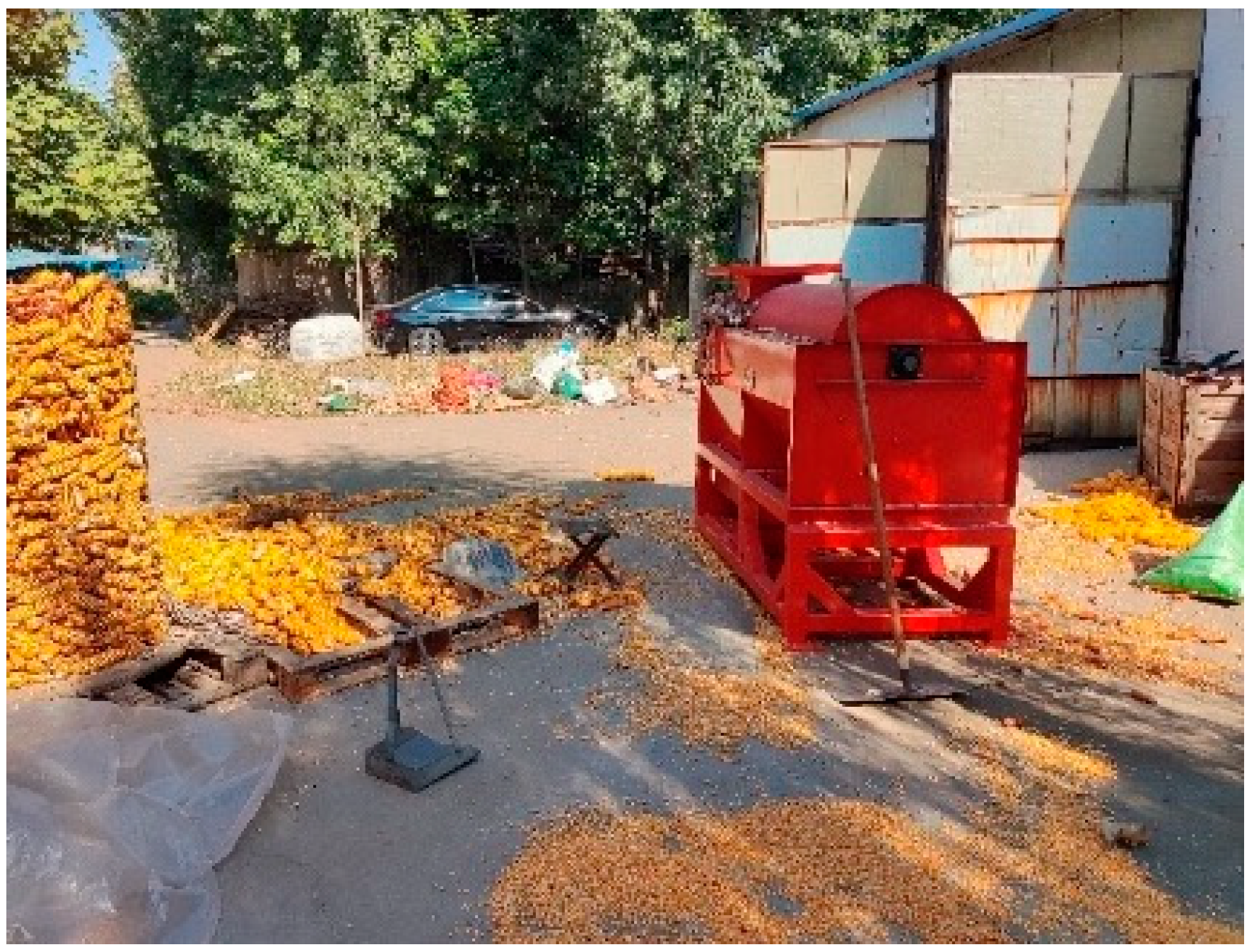
| Parameter | Numerical Value |
|---|---|
| Rotor speed/r/min | 0~600 |
| Rotor length/mm | 1650 |
| Rotor diameter/mm | 540 |
| Threshing gap/mm | 30~50 |
| Intaglio package angle/° | 200 |
| Total supporting power/kW | 145 |
| Feeding area length/mm | 225 |
| Threshing area length/mm | 1100 |
| Separated area length/mm | 225 |
| Parameter | Numerical Value |
|---|---|
| Average length/mm | 172 ± 0.5 |
| Big end diameter/mm | 46.4 ± 0.2 |
| Small end diameter/mm | 42.2 ± 0.2 |
| Moisture content/% | 30.5 ± 0.5 |
| Level | Factor | ||
|---|---|---|---|
| Rotor Rotation Speed (X1) r/min | Threshing Gap (X2) mm | Initial Spring Stiffness (X3) N/mm | |
| −1 | 325 | 40 | K1 = 7.8 ≈ 7.5 |
| 0 | 375 | 45 | K2 = 12.5 |
| 1 | 425 | 50 | K3 = 17.3 ≈ 17.5 |
| Numerical Order | Test Factor Level | Indicators for Performance Appraisal | |||
|---|---|---|---|---|---|
| X1 | X2 | X3 | Breakage Rate | Unthreshed Rate | |
| 1 | −1 | 0 | 0 | 5.2 | 0.6 |
| 2 | 1 | 0 | 0 | 6 | 0.49 |
| 3 | −1 | 1 | 0 | 6.3 | 0.67 |
| 4 | 1 | 1 | 0 | 7 | 0.53 |
| 5 | −1 | −1 | −1 | 6.5 | 0.58 |
| 6 | 1 | −1 | −1 | 7.3 | 0.53 |
| 7 | −1 | −1 | 1 | 6.2 | 0.58 |
| 8 | 1 | −1 | 1 | 6.5 | 0.48 |
| 9 | 0 | 0 | −1 | 5.7 | 0.53 |
| 10 | 0 | 1 | −1 | 6.9 | 0.56 |
| 11 | 0 | 0 | 1 | 5.6 | 0.51 |
| 12 | 0 | 1 | 1 | 6.8 | 0.53 |
| 13 | 0 | −1 | 0 | 4.85 | 0.51 |
| 14 | 0 | −1 | 0 | 4.85 | 0.5 |
| 15 | 0 | 0 | 0 | 4.7 | 0.52 |
| 16 | 0 | −1 | 0 | 4.8 | 0.51 |
| 17 | −1 | −1 | 0 | 4.75 | 0.5 |
| Source | Sum of Squares | Df | Mean Square | F-Value | p-Value | |
|---|---|---|---|---|---|---|
| Model | 12.69 | 9 | 1.41 | 170.81 | <0.0001 | Significant |
| X1 | 0.8297 | 1 | 0.8297 | 100.49 | <0.0001 | |
| X2 | 3.00 | 1 | 3.00 | 363.12 | <0.0001 | |
| X3 | 0.1274 | 1 | 0.1274 | 15.43 | 0.0057 | |
| X1 X2 | 0.0114 | 1 | 0.0114 | 1.38 | 0.2791 | |
| X1 X3 | 0.0625 | 1 | 0.0625 | 7.57 | 0.0284 | |
| X2 X3 | 0.0828 | 1 | 0.0828 | 10.03 | 0.0158 | |
| X12 | 3.08 | 1 | 3.08 | 372.80 | <0.0001 | |
| X22 | 1.07 | 1 | 1.07 | 129.61 | <0.0001 | |
| X32 | 4.04 | 1 | 4.04 | 489.77 | <0.0001 | |
| Residual | 0.0578 | 7 | 0.0083 | |||
| Lack of Fit | 0.0408 | 3 | 0.0136 | 3.20 | 0.1453 | Not significant |
| Pure Error | 0.0170 | 4 | 0.0042 | |||
| Cor Total | 12.75 | 16 |
| Source | Sum of Squares | Df | Mean Square | F-Value | p-Value | |
|---|---|---|---|---|---|---|
| Model | 0.0360 | 9 | 0.0040 | 37.20 | <0.0001 | Significant |
| X1 | 0.0215 | 1 | 0.0215 | 199.53 | <0.0001 | |
| X2 | 0.0062 | 1 | 0.0062 | 57.27 | 0.0001 | |
| X3 | 0.0012 | 1 | 0.0012 | 11.05 | 0.0127 | |
| X1 X2 | 0.0015 | 1 | 0.0015 | 13.70 | 0.0076 | |
| X1 X3 | 0.0006 | 1 | 0.0006 | 5.81 | 0.0467 | |
| X2 X3 | 4.545 × 10−6 | 1 | 4.545 × 10−6 | 0.0423 | 0.8430 | |
| X12 | 0.0058 | 1 | 0.0058 | 54.33 | 0.0002 | |
| X22 | 0.0008 | 1 | 0.0008 | 7.32 | 0.0304 | |
| X32 | 0.0000 | 1 | 0.0000 | 0.2961 | 0.6032 | |
| Residual | 0.0008 | 7 | 0.0001 | |||
| Lack of Fit | 0.0005 | 3 | 0.0002 | 2.25 | 0.2246 | Not significant |
| Pure Error | 0.0003 | 4 | 0.0001 | |||
| Cor Total | 0.0368 | 16 |
Disclaimer/Publisher’s Note: The statements, opinions and data contained in all publications are solely those of the individual author(s) and contributor(s) and not of MDPI and/or the editor(s). MDPI and/or the editor(s) disclaim responsibility for any injury to people or property resulting from any ideas, methods, instructions or products referred to in the content. |
© 2024 by the authors. Licensee MDPI, Basel, Switzerland. This article is an open access article distributed under the terms and conditions of the Creative Commons Attribution (CC BY) license (https://creativecommons.org/licenses/by/4.0/).
Share and Cite
Niu, L.; Zha, Z.; Yang, H.; Ma, J.; He, Q.; Wang, Y.; Cui, Y.; Li, X.; Geng, D. Design and Experiment of Flexible Threshing Device with Variable Stiffness for Corn. Agriculture 2024, 14, 836. https://doi.org/10.3390/agriculture14060836
Niu L, Zha Z, Yang H, Ma J, He Q, Wang Y, Cui Y, Li X, Geng D. Design and Experiment of Flexible Threshing Device with Variable Stiffness for Corn. Agriculture. 2024; 14(6):836. https://doi.org/10.3390/agriculture14060836
Chicago/Turabian StyleNiu, Lin, Zehao Zha, Haoran Yang, Jie Ma, Qinghao He, Yanan Wang, Yipeng Cui, Xiang Li, and Duanyang Geng. 2024. "Design and Experiment of Flexible Threshing Device with Variable Stiffness for Corn" Agriculture 14, no. 6: 836. https://doi.org/10.3390/agriculture14060836




